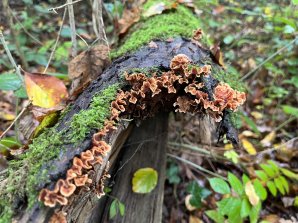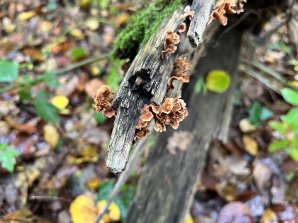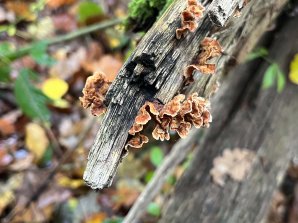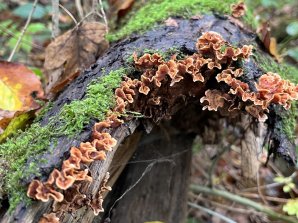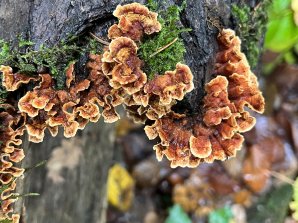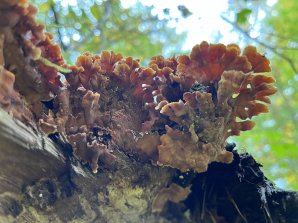Stereum hirsutum
Description
Stereum hirsutum is a common and widespread hardwood-loving crust fungus that is often confused with Trametes versicolor (Turkey Tail).
Stereum hirsutum are saprobic on dead wood of hardwoods, especially oaks. They grow densely from gaps in bark, and then fuse together laterally, causing a white rot of the heartwood. This can often serve as a host to algae, and it even sometimes parasitized by jelly fungi. The fungus is prevalent throughout all seasons of the year.
The main difference between the False Turkey Tail and the true Turkey Tail is that the False Turkey Tail has a smooth undersurface while the underside of the true Turkey Tail is covered in tiny pores.
Common names: False Turkey Tail, Hairy Curtain Crust.
Mushroom Identification
Ecology
Saprobic on the deadwood of hardwoods, especially oaks; growing densely gregariously, often from gaps in the bark, fusing laterally; causing a white rot of the heartwood; often serving as a host to algae; sometimes parasitized by jelly fungi; spring, summer, fall, and winter; widely distributed in North America.
Fruiting Body
Individually .5-3 cm across, but often fused together; fan-shaped, semicircular, or irregular; densely velvety, hairy, or with appressed hairs; with concentric zones of texture and color; colors variable, but generally ranging from yellow to tan, brown, reddish-brown, or buff (sometimes developing greenish shades in old age as a result of algae); laterally attached, without a stem.
Undersurface
Smooth; yellowish to yellow-brown or grayish brown; sometimes bruising darker yellow.
Flesh
Insubstantial; tough.
Spore Print
White; difficult to obtain.
Microscopic Features
Spores 5-8 x 2-3.5 µ; smooth; cylindric or narrowly elliptical; amyloid. Hyphidia with rounded to subacute apices; without projections (pseudoacanthohyphidia and acanthohyphidia absent).
Medicinal Properties
Clinical tests have shown it has food antioxidant properties. Benzoate extract of its mycelia is also actively antimicrobial against methicillin-resistant Staphylococcus aureus. It also contains four epidioxysterols, of which two (1,4) possess significant activity against TB Mycobacterium tuberculosis.
Dry extract of Stereum hirsutum has significant inhibitory activity on thrombin (due to glycerolipids). This means that it could be used to make a blood-thinning medication as an alternative to the dangerous drug warfarin.
In the environment, Stereum hirsutum has been used to decontaminate Bisphenol A (BPA) and 4-n-nonylphenol (NP) (endocrine disrupting compounds that leach from waste plastic) from river water sediment inoculated with the fungus. These compounds are particularly dangerous to both aquatic life and humans. Turkey Tail fungi (Trametes versicolor) also do this extremely well, being superior in decontaminating lake sediment.
Stereum hirsutum Similar Species
Stereum sanguinolentum (Albertini & Schweinitz ex Fries)
Fries, growing only on conifers: (Pinus, Picea and Larix); Stereum rugosum (Persoon ex Fries) Fries, which, however, grows on broad-leaved, especially Fagus and whose spores are bigger; Stereum gausapatum (Fries) Fries, also growing on broad-leaved but on wood of Quercus, with slightly longer spores.
Stereum ochraceoflavum (Schweinitz)
Saccardo, is a small species with paler colours on the whitish-gray on the sterile part, the hymenium pale grey or gray-yellowish, growing on small branches of broad-leaved, especially Quercus.
Stereum reflexulum D. A.
Reid which is a resupinate southern Europe species, growing on broad-leaved trees and on bushes, with cap having a grey surface, small (0,5 cm), often with pink hues on the hymenium.
History
The Hairy Curtain Crust fungus was described in 1787 by German naturalist Carl Ludwig von Willdenow (1765 - 1812) who gave it the scientific binomial name Thelephora hirsuta. It was British mycologist Samuel Frederick Gray (1766 - 1828) who in 1821 transferred this species to the genus Stereum, establishing its currently-accepted scientific name as Stereum hirsutum.
Synonyms of Stereum hirsutum include Helvella acaulis Huds., Auricularia reflexa Bull., Thelephora hirsuta Willd., Boletus auriformis Bolton, and Auricularia aurantiaca Schumach.
Stereum, the generic name, means tough, and crust fungi in this genus certainly can be difficult to tear when you want to take a small sample for investigation. The specific epithet hirsutum means hairy (hirsute, indeed!), and the upper surfaces of these irregularly-shaped tiered brackets are distinctly hairy when the fruitbodies are young and fresh; however, they do become smoother with age.
The common name Hairy Curtain Crust reflects (in the 'curtain' part) the rippled form of edges of the fruitbodies, which do look like partly-drawn curtains; however, it's very much more common to see this species growing in the form of tiers of reflexed crusts or brackets, particularly on standing deadwood than as resupinate crusts (although the latter form does occur, and I see this most often on the ends and vertical faces of stacked sawn timber).
Video
Photo copyright:
All photos were taken by the Ultimate Mushroom team and can be used for your own purposes under the Attribution-ShareAlike 4.0 International license.

